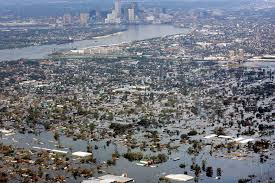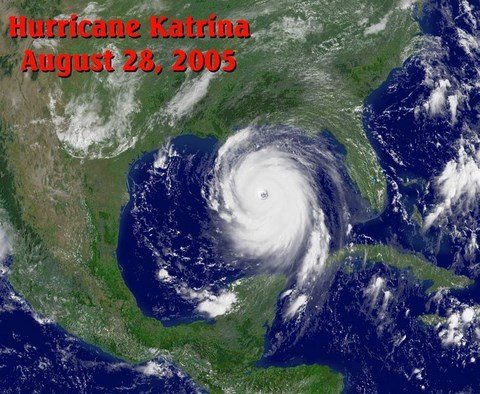Hurricane Katrina: Was New Orleans flooded by the Mississippi waters?
by Vladimir Pudov


Two hurricanes of such intensity as Katrina and Rita - are an epochal event. Such powerful hurricanes - of the 5th category - are observed extremely rarely in the Atlantic Ocean. Within the last 65 years, only two hurricanes of such intensity hit the US coast - these were Camilla (1969) and Andrew (1992).
Why do these monsters, like Amazon pythons, periodically crawl out of the Atlantic Ocean precisely in the Gulf of Mexico? Oil derricks may be guilty, as they contaminate the superficial water of this almost closed water area. An oil film of a thickness of only 20 to 30 Angström reduces the evaporation of superficial water by 20 percent and more. The waters of the Gulf of Mexico become overheated as the natural ocean/atmosphere power interchange balance is broken. The upper-layer water temperature reaches 30 degrees C! The excess energy is evacuated via hurricanes. This is a natural mechanism of a heat sink in anomalously overheated water areas of the World Ocean.
The power of hurricane Katrina on one day, August 29, 2005, was equal to about 20 billion kW!
See: Vladimir Pudov: How does Pollution fo the World Ocean contribute to the "Greenhouse Effect?"
Why the hurricane flooded New Orleans.
Katrina, coming out of the overheated waters of the Gulf of Mexico on August 26, began to gain strength abruptly and on August 28 it reached the 5th and last stage. Wind velocity exceeded 60 meters per second! The diameter of the eye of the hurricane was approximately 100 kilometers, and the pressure inside it dropped disastrously.
New Orleans is about 2 meters below sea level. However, the city is located not on the coast of the Gulf of Mexico, but about 60 kilometers inland to the north, on the bank of the biggest river of North America - the Mississippi. Several dozen kilometers of causeways protect New Orleans from the waters of neighbouring Lake Pontchartrain. As the US mass media have stated, water rushed from the lake through breaches in destroyed causeways and flooded the city. But in this case, the flood level should not have exceeded two meters. However, witnesses' evidence indicates that the water-level in the city reached as high as 6 to 8 meters. There are all grounds to believe that the city was flooded by the Mississippi waters, additionally to Lake Pontchartrain.
The reason to believe this is as follows: the eye of hurricane Katrina steered directly to the Mississippi estuary, it was moving towards the north practically along the river. The eye of the hurricane blocked the river stream. The point I am making here is that the water surface level in the eye of hurricane is lifted, and it is lifted the higher, the more the atmospheric pressure in the eye is low in relation to the eye's surroundings and taking into consideration differences of water and air densities. This is the so-called ocean's barotropic reaction to the hurricane. The difference in atmospheric pressure between the eye and its surroundings was equal to more than 110 millibars! This means that in the eye of the hurricane (its diameter making approximately 100 kilometers), the water-level was more than a meter higher than that of the surrounding water surface! And this aqueous " hump " (soliton wave) blocked the Mississippi River.
This is much like a tsunami. However, this soliton wave was driven towards New Orleans by the eye of hurricane. Water discharge in the Mississippi makes 19,000 cubic meters per second (reference data). It is easy to calculate that within 6 to 8 hours of the hurricane moving up-stream, the Mississippi waters would flood an area of 100 square kilometers to a height of 4.1 to 5.5 meters. And this in our opinion is the root cause for the city flooding. Certainly, precipitation and causeway breaches contributed to New Orleans' flood. However, it was the unlikely coincidence of the above events which drowned this beautiful city.
When hurricane Rita reached the mainland, New Orleans again found itself in a bad situation. Rita passed to the west of the Mississippi, to the west of New Orleans, but its scope was such that wind velocity in the region of the Mississippi was extremely high and, most importantly, the strong wind was again directed against the river stream. New Orleans was drowned in floods once more.
Unfortunately, science is unable so far to provide methods to protect from such natural phenomena.
See also: On a possible role of electromagnetic effects in the Atmosphere-Ocean coupling in Tropical Cyclones
by Vladimir Pudov

Vladimir Pudov

